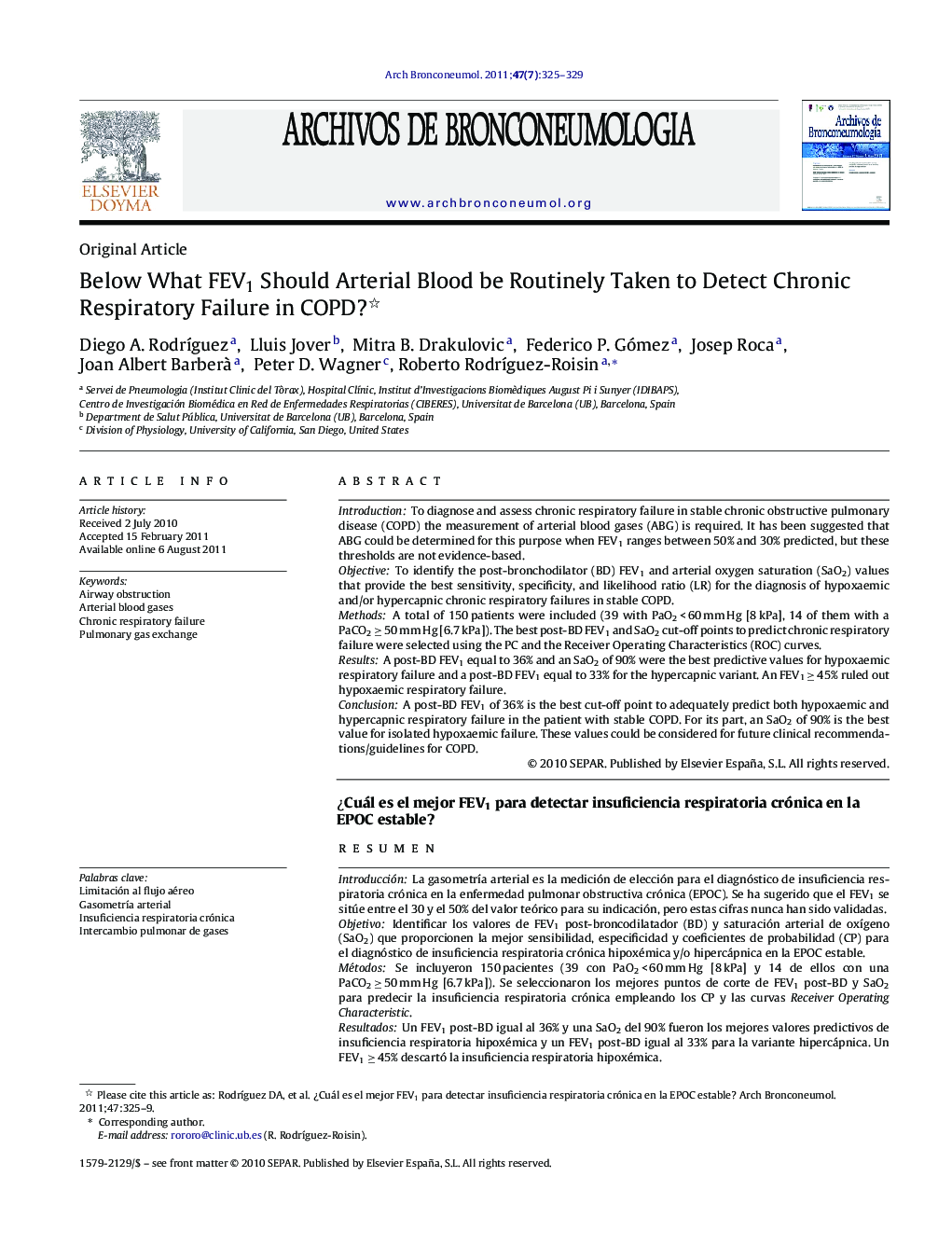| Article ID | Journal | Published Year | Pages | File Type |
|---|---|---|---|---|
| 4206212 | Archivos de Bronconeumología (English Edition) | 2011 | 5 Pages |
IntroductionTo diagnose and assess chronic respiratory failure in stable chronic obstructive pulmonary disease (COPD) the measurement of arterial blood gases (ABG) is required. It has been suggested that ABG could be determined for this purpose when FEV1 ranges between 50% and 30% predicted, but these thresholds are not evidence-based.ObjectiveTo identify the post-bronchodilator (BD) FEV1 and arterial oxygen saturation (SaO2) values that provide the best sensitivity, specificity, and likelihood ratio (LR) for the diagnosis of hypoxaemic and/or hypercapnic chronic respiratory failures in stable COPD.MethodsA total of 150 patients were included (39 with PaO2 < 60 mm Hg [8 kPa], 14 of them with a PaCO2 ≥ 50 mm Hg [6.7 kPa]). The best post-BD FEV1 and SaO2 cut-off points to predict chronic respiratory failure were selected using the PC and the Receiver Operating Characteristics (ROC) curves.ResultsA post-BD FEV1 equal to 36% and an SaO2 of 90% were the best predictive values for hypoxaemic respiratory failure and a post-BD FEV1 equal to 33% for the hypercapnic variant. An FEV1 ≥ 45% ruled out hypoxaemic respiratory failure.ConclusionA post-BD FEV1 of 36% is the best cut-off point to adequately predict both hypoxaemic and hypercapnic respiratory failure in the patient with stable COPD. For its part, an SaO2 of 90% is the best value for isolated hypoxaemic failure. These values could be considered for future clinical recommendations/guidelines for COPD.
ResumenIntroducciónLa gasometría arterial es la medición de elección para el diagnóstico de insuficiencia respiratoria crónica en la enfermedad pulmonar obstructiva crónica (EPOC). Se ha sugerido que el FEV1 se sitúe entre el 30 y el 50% del valor teórico para su indicación, pero estas cifras nunca han sido validadas.ObjetivoIdentificar los valores de FEV1 post-broncodilatador (BD) y saturación arterial de oxígeno (SaO2) que proporcionen la mejor sensibilidad, especificidad y coeficientes de probabilidad (CP) para el diagnóstico de insuficiencia respiratoria crónica hipoxémica y/o hipercápnica en la EPOC estable.MétodosSe incluyeron 150 pacientes (39 con PaO2 < 60 mm Hg [8 kPa] y 14 de ellos con una PaCO2 ≥ 50 mm Hg [6.7 kPa]). Se seleccionaron los mejores puntos de corte de FEV1 post-BD y SaO2 para predecir la insuficiencia respiratoria crónica empleando los CP y las curvas Receiver Operating Characteristic.ResultadosUn FEV1 post-BD igual al 36% y una SaO2 del 90% fueron los mejores valores predictivos de insuficiencia respiratoria hipoxémica y un FEV1 post-BD igual al 33% para la variante hipercápnica. Un FEV1 ≥ 45% descartó la insuficiencia respiratoria hipoxémica.ConclusiónUn FEV1 post-BD igual al 36% se erige en el mejor punto de corte para predecir adecuadamente tanto la insuficiencia respiratoria hipoxémica como la hipercápnica en el paciente con EPOC estable. Por su parte, una SaO2 del 90% ofrece el mejor valor para la insuficiencia hipoxémica aislada. Estos valores podrían ser considerados para futuras recomendaciones/guías clínicas de la EPOC.
